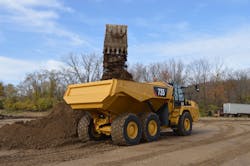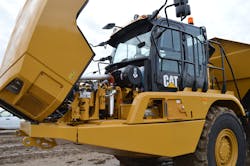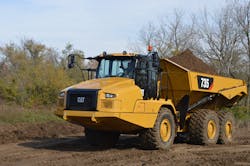Cat 735 Redesign Emphasizes Efficiency
"In the past, this was a large truck with a smaller body. With the 735 redesign, we’ve cut out the unnecessary ‘fat’ that existed when we used the structures and power train from the 740 and 745 [larger Caterpillar articulated-truck models] to move only 35 tons. The 735’s design is lean and efficient, rather than unnecessarily heavy-duty. Power, performance, and efficiency are right in line with capacity.”
That’s how Scott Thomas, product application specialist, articulated trucks, summed up the significant redesign of the Cat 735, introduced fall 2018, as he gave a feature walk-around to those assembled for a recent Construction Equipment field test at Operating Engineers Local 649’s training facility in Bartonville, Illinois. Those assembled included CE editors and our test operator Todd Shreves, an instructor in Local 649’s apprentice training program.
The late-October test day was sunny and seasonably warm, but a downpour the night before left ankle-deep mud in the loading area and on the haul roads where the new truck would be working—perfect conditions for the 6x6 hauler equipped with Caterpillar’s automatic Advanced Traction-Control system.
The new 735, compared with its 735C predecessor, is some 13,500 pounds lighter and nearly 2 feet shorter in overall length when both are equipped with a tailgate. The new truck’s design overhaul, however, preserved virtually all of the 735C’s capacity, both in payload weight and volume. The 36.0-ton capacity of the 735C is just slightly more than the 735’s 35.3 tons; SAE 2:1 heaped capacity (with tailgate) was 28.7 cubic yards for the 735C; it’s 27.9 cubic yards for the 735.
“In round numbers, the 735 has an empty weight about 22 percent less than the 735C, but retains some 98 percent of its predecessor’s capacity,” said Thomas. “Given this more-efficient design, coupled with power-train changes, we’ve seen fuel-efficiency gains approaching 19 percent in some applications.”
The powertrain changes Thomas noted are significant. The 735C’s 15.2-liter Cat C15 engine has been replaced in the 735 with the 12.5-liter C13. Power ratings, however, are not that disparate; the C15 was rated 441 horsepower (net, SAE J1349), and the C13’s net rating in the 735 is 424. The 735’s more advantageous power-to-weight ratio, said Thomas, contributes to the new model’s overall increase in efficiency.
Coupled to the C15 in the 735C was a Cat 9F/2R power-shift transmission, which is replaced in the 735 with the Cat CX31 transmission, a 6F/1R power-shift that actually has a slightly higher top-gear speed, 35.0 versus 33.5 mph.
“The new transmission and the smaller engine ‘right-size’ the powertrain for the truck’s weight loss,” Thomas told us.
The CX31, as did the 735C’s transmission, features a long-list of Caterpillar design features, among them Advanced Productivity Electronic Control Strategy and Electronic Clutch-Pressure Control, which combine to deliver a number of advantages, Thomas said, including variable shift points to match operating conditions, maintaining converter lock-up on grades to preserve ground speed during shifts, and modulated clutch engagement to smooth gear changes.
Axles under the new truck are similar in design to those for the 735C, but use internal wet-disc brakes, versus the 735C’s out-board wet-disc brakes. All three axle differentials are torque-proportioning and equipped with a variable hydraulic-clutch lock, as is the inter-axle differential. Sensors in the 735’s Advanced Automatic Traction Control System monitor ground speed and wheel speed, said Thomas, and the differential locks are proportionally applied when the system senses loss of traction.
“The automatic traction-control system in the 735 is similar to that in the 735C,” Thomas said, “but the system in the new truck is ‘proactive’—it begins to engage the differential locks when it senses an increase in rolling resistance or when the engine begins to lug. The system is also designed to manage torque during turns.”
New cab, refined features
A major emphasis when reengineering the 735, said Thomas, was the operator’s environment. Before explaining features in and around the cab, Thomas opened a small compartment in the 735’s left front fender and flipped the “wake-up” switch, which energizes the truck’s ECMs and turns on lights that illuminate the cab steps. The compartment also includes a ground-level fuel shutoff.
Standing on the platform at the top of the steps, Thomas pushed the mirror assembly flat against the cab, illustrating the ease of dealing with the mirrors during transport. He then pushed the mirrors forward, parallel with the cab, to illustrate how the mirrors can be positioned for protection if the truck must back through potential obstacles, such as low-hanging branches. The convex mirror positioned in front of the grille, he said, gives the operator a clear view close to the nose of the truck. Side mirrors can be heated and powered as an option.
Still on the subject of visibility, Thomas pointed out that the C pillars (at the rear corners of the cab) have been removed from the 735, significantly improving visibility over the operator’s shoulder. Removing the C pillars, he said, was possible with the cab’s new external “spinal-ROPS” design, allowing the side and rear glass panels to come together with a near-invisible seam. A rearview camera system is standard.
The 735’s cab is a fresh design, compared with the 735C, and features a center-mounted air-suspension seat and a smaller, but comfortable, “trainer’s seat” to the left and slightly behind the operator. The climate-controlled, pressurized cab uses improved door seals, and its overall design, said Thomas, lowers interior sound levels to 72 dB(A)—7 dB(A) lower than the 735C.
In the cab, Thomas called our attention to three automated systems: Automatic Retarder Control; Assisted Hoisting Control; and Stability Assist—all proprietary Caterpillar designs.
The 735’s retarding system uses an engine compression brake, a fluid-type retarder in the transmission, and the truck’s service brakes. The engine brake does most of the heavy lifting, said Thomas, supplying some 80-plus percent of total retarding force. The system has four settings: off; medium; high; and automatic. Selecting either the medium or high setting determines the degree of retardation, essentially telling the engine brake to use either four or six cylinders, respectively. In the automatic mode, the system has more choices—off, low, medium, and high—which are automatically selected as operating condition dictate.
“Automating the retarder relieves the truck operator of one of the most demanding tasks in controlling the vehicle—deciding when and to what degree to apply retarding force,” said Thomas. “But on the other hand, we didn’t want to take that control away from experienced operators if manual control is their preference—they can simply shut off the system.”
Likewise, if the operator chooses to control all aspects of the dumping process, the 735’s Hoist Assist system can be shut off with a push of a switch on the right console. But if the system is switched on, the operator simply lifts another switch, positioned on the forward side of the automotive-type transmission controller, to initiate a series of automatic functions (provided the truck is either stopped or travelling less than 4 kph): transmission neutralizes; service brakes apply; engine speed elevates; and body raises. A second click of the switch reverses the process and allows a soft landing of the body on the frame.
“We estimate that using the hoist-assist feature reduces operator interaction by as much as 50 percent,” said Thomas.
Watch Cat's video demo of Hoist Assist
The 735’s Stability Assist system, Thomas told us, uses two inertial measurement units (position-sensing instruments using gyroscopes and accelerometers) to continuously monitor the degree of roll of the body and the tractor, as well as the longitudinal angle of the truck. The system alerts the operator via the monitor when any of these parameters are approaching a critical point during travel or dumping, stopping the dumping process if instability is sensed.
Convenience features for the 735 include large mirror assemblies, which can be easily pushed against the cab during transport, and a covered panel in the left fender that contains a fuel-shutoff as well as a “wake-up” switch, which energizes all the truck’s ECMs and turns on lights that illuminate the steps.
On the haul road
The 735 arrived at Local 649 with a number options, including heated/powered mirrors, heated/cooled seat, automatic lubrication system, exhaust-heated body, tailgate, and a payload-management system (Cat Production Measurement).
The latter option uses eight strain gauges in the truck’s walking-beam suspension to signal the loading-vehicle operator, via red and green lights at the top corners of the cab, when the truck is nearing capacity. Load information appears on the in-cab touch-screen—including payload weights, load/cycle counts, and daily totals—all of which can be transmitted back to the office via the truck’s Product Link telematics system.
With the 735 loaded, 649’s Shreves made an initial run, with Thomas in the trainer’s seat, along a haul road constructed around the Local’s extensive acreage, having a number of positive and negative grades. Shreves then spent the better part of the morning operating the 735.
CE editors then sat down with Shreves in one of the Local’s classrooms to ask his impressions and opinions about the 735’s design, performance, and features. His comments follow:
Initial impressions
“Overall I think the truck is very stable—very clean design on the inside—instrumentation is well-placed and easy to use—the monitor easy to read. It’s an operator friendly truck that has a number of enhancements that earlier truck models I’ve operated didn’t have.
“The payload-management system, I think, would be a good investment for owners wanting to avoid overloading in the interest of saving tires—and promoting safety.
“Visibility is excellent—especially with the rear corner posts removed. I think operators will appreciate the mirror at the front, because that can be a blind spot. And the backup camera has become a necessity.
“The heated seat is very comfortable—and welcome on chilly morning like this. A heated/cooled seat seems like a small item, but it’s something that operators appreciate, and if you’re comfortable, you’re more productive.
Power
“The machine has plenty of power. When you hear that Caterpillar moved down from a 15-liter to 13-liter engine in the truck, your first reaction might be that performance will be compromised, but that doesn’t seem to be the case. There’s no lack of power—that was evident on the uphill grades, especially with the muddy ground conditions that we had.
“The transmission was pretty much seamless—shifts were smooth.”
Traction
“The automatic traction control seemed to work well—really no apparent wheel slip that I could tell. And, like I say, I think the ground conditions we had on the haul road were a good test of how well the truck can negotiate sloppy conditions.
“Trucks I’ve operated in the past had a pedal on the floor—or maybe switches that you had to hit—to engage the differential locks. And when you’re trying to control traction manually, you’re always having to anticipate when exactly to apply the system.
“It can be a split-second decision, and how you react might be the difference between making it through or getting stuck. But as Scott said, this system is not only automatic, but it’s proportional—you’re getting just the right amount of control, and you can see how the system is operating on the monitor.
“Along with having good traction, the truck seems to have very positive steering. There were spots where I was expecting the truck to drift one way or another, considering the slime on the top of the haul road, but it always stayed on track. And it has a fairly compact turning radius, which could be important in some situations.”
Retarding
“To be honest, I used the system in automatic. There’s a couple fairly steep downhill grades on the haul road, but probably nothing as challenging as you might encounter in a quarry, for instance. I thought the system reacted well on the grades; I always felt in control.
“There might be some instances where an operator might choose to turn off the system to go a bit faster than the automatic mode might allow, but the system has enough choices when it’s turned on, that I’d think most operators could find something to their liking.”
Automated dumping
“Being able to lift that hoist-assist switch and have the entire dumping process automated is a real boon for operators. If you’re making maybe 80 to 100 cycles a day, the automated system is saving you a lot of effort.
“With a manual dumping system, no matter how many times a day you might repeat the process, you always have to be thinking about what you’re doing. That’s not to say that this automatic system lets you off the hook for keeping your mind on the task at hand, but it does eliminate a lot of repetitive motion, which adds to fatigue. But, the fact that you can turn off the system is a good idea, because you might on occasion be in a situation where you want the closely control the dumping process.”
Stability
“The stability-assist system is another feature operators will appreciate. If you’re working in a large fill area, for example, where a dozer is knocking down piles and the trucks keep graduating backwards, it would be easy to drop an axle. You might feel stable enough in the cab, but the truck is actually in danger of tipping. Getting a caution alert gives you a chance to correct the situation. I think the system has the potential to keep things a lot safer.”
Details
“The automatic greaser is a good idea, because there’s probably a lot of points to grease on that machine that could be easily missed. And grouping all the filters together on one side should simplify service. Also, being able to push the mirrors out of the way when you’re doing routine engine checks is handy. And when you’re transporting the machine, there’s no bolts to remove from the mirrors.
“The wake-up switch is a good idea—puts a light on the steps. Climbing the steps in the dark, or trying to negotiate the steps with a flashlight in hand while keeping three points of contact, can be dangerous.”


